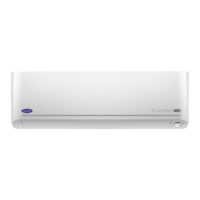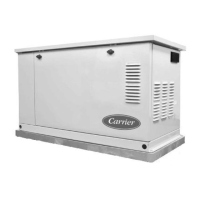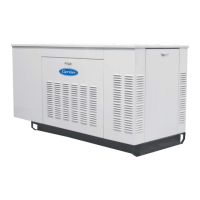2–5 T-361
b. Oil Pressure Sender (see Figure 2.5)
This device senses engine lube oil pressure and transmits a signal to the oil pressure gauge. The oil
pressure sender is located on the oil filter housing.
c. Water Temperature Gauge (see Figure 2.6 or Figure 2.7)
The function of this gauge is to observe water operating temperature. The gauge is connected to the
water temperature sender.
d. Water Temperature Sender
This device (see Figure 2.2) senses engine water temperature and transmits a signal to the water tem-
perature gauge. The water temperature sender is located on the top, left-hand side of the engine below
the high water temperature switch.
e. Auto Restart Module (If Equipped) (see Figure 2.7)
Auto start/restart is provided to simplify the start-up process and provide an automatic restart feature that
will automatically attempt to restart the unit in the event of some shutdowns. Four LEDs are used to indi-
cate shutdown from overcrank, overspeed, low oil pressure, and high water temperature. A fifth LED is
used to indicate the unit is running. Refer to Table 2–2 for system preset values.
The auto restart function will perform a series of six attempts to restart the unit and make three attempts
within each series. Once the function has completed all 18 attempts the unit will automatically lock out
future crank attempts. Refer to Table 2–3 for detailed information on auto restart sequencing.
2. Meters
a. Ammeter (A) (see Figure 2.6 or Figure 2.7)
The ammeter is an indicator of the charging system and unit electrical draw. It indicates the rate of dis-
charge or charge of the battery. During start up, the intake heater draws approximately 42 amps.
b. Total Time Meter (TT) (see Figure 2.6 or Figure 2.7)
This meter designates the total hours and provides an accurate readout of accumulated engine running
time. This data can be used to establish the proper periodic maintenance schedule. (Refer to Table 5–1.)
3. Manual Switches
a. Intake Heater Switch (HS)
The intake heater switch is of the momentary type. When held in the PREHEAT position, the switch
allows approximately 42 amps of battery current to flow into the intake heater. This, in turn preheats the
air within the intake manifold and allows the engine to start. After starting the engine, the intake heater
switch should continue to be held in the ON position for approximately 5 seconds until the engine has
developed enough oil pressure to close the oil pressure safety switch.
b. Ignition Switch (IGN) (see Figure 2.6)
The ignition switch is of the momentary type to be used in the OFF/ON/START positions. When held in
the START (ignition) position, it energizes the starter motor solenoid, which in turn allows the starter
motor to crank the engine. The switch is released to the RUN position once the engine has started.
c. Ignition Switch (IGN) (Auto Restart) (see Figure 2.7)
The ignition switch is of the maintained contact type to be used in the RUN/OFF positions. When
switched to the RUN position, it energizes the control module, which in turn controls all functions of the
generator set.
4. Timers
a. Intake Heater Timer (IHT) (If Equipped)
The intake heater timer continues to supply power to the intake heater for 3 minutes after initial start- up.
b. Starter Timer
The Starter Timer limits the amount of time that the starter can be engaged to 15 seconds. If the starter is
manually engaged for more than 15 seconds, power will be cut to the starter. Once power has been
removed, the starter can again be engaged for up to 15 seconds.

